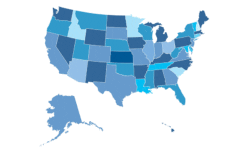USC Campus Security: Taking It to the Streets
The University of Southern California has drastically reduced violent crimes by introducing video surveillance, security ambassadors and community programs into the neighborhoods surrounding campus.

Camera operators monitor the dome cameras around campus 24 hours a day in a command center located in USC's Department of Public Safety office.
Drayton says that his officers and the security ambassadors patrol the areas around campus in unpredictable patterns, so that potential criminals will be unable to anticipate their movements.
“You want to see a train come at a certain time. That doesn’t work when you’re trying to stop crime because any kind of discernable pattern becomes something that is used against you by the people who are trying to defeat the system,” he explains.
USC’ s No. 1 Goal is Crime Prevention
Video surveillance, patrols and community outreach have allowed USC to combat crime in what Drayton calls a “three-pronged approach.”
The department’s first goal, Drayton says, is to prevent crime from happening entirely. This is accomplished by layering security so that potential criminals will avoid the patrol area all together.
“This is the number one goal for us because I don’t want a student to have to go through an incident,” Drayton says.
Secondly, “If we can’t prevent it from happening, then we want to catch the person in the act,” by responding to suspicious activity, Drayton says. The third prong, which is used if USC’s officers aren’t able to stop a crime in progress, is to use the university’s camera system to launch an investigation and apprehend the criminal.
“The really cool thing about this technology is, we can show in court the intent of a vehicle or the persons who are driving that vehicle [to commit a crime],” Drayton explains. “We can show the number of times they went by our license plate recognition cameras.”
The department’s combination of crime prevention strategies has been a success, Drayton says.
“Every place that we have implemented this, I’m happy to report that we have seen a tremendous, immediate drop in crime.”
Campus Reaches Out to the Community
In order to better patrol the surrounding neighborhoods and benefit its community, USC has implemented a number of programs. Chief Carey Drayton co-chairs a public safety task force, which has partnered with Los Angeles Unified School District (LAUSD) police to protect students walking to and from local schools, curb the activities of unlicensed food vendors and provide education for parents.
USC’s Kid Watch program prevents bullying and gang violence by recruiting volunteers from the community to sit outside their houses during the times when children would be walking to and from school.
Background checks are performed on these volunteers, and stickers identifying them as part of the Kid Watch program are placed on their homes.
“These people help students and serve a very similar role to that of security ambassadors except that they are volunteers,” Drayton explains.
Officer Aaron Pettus says USC’s officers have an excellent relationship with the surrounding community.
“During my first couple weeks on the job, one of my field training officers was talking to different people on a first name basis, and that impressed me,” Pettus says. “He told me that when you’re patrolling 10 hours a day, you better get out here and meet some people. Whether it’s a business owner, the post man or the transient that’s in the area, we try to know pretty much everybody that is coming in and out of [the neighborhoods].”
University Provides Safety, Health Education
USC recently began to monitor the activity of local food vendors selling snacks to school children.
“Some of this food is not packaged appropriately, or is substandard food,” Chief Carey Drayton says. “We’ve come up with a health program … so we can educate the parents and kids and educate the vendors about what they’re doing.”
Instruction is provided by peer educators from the USC Government and Civic Engagement office that operate out of the university-owned Community House, located near campus.
USC’s public safety officers also provide safety training for community members at least four times a year.
Additionally, the university supports 11 nearby elementary, middle and high schools as part of its Good Neighbors Campaign, which was started in 1994 by USC’s then-president Steven Sample.
“We have a family of schools, which are elementary, middle and high schools that we have ties to both administratively and financially,” Drayton explains. “We support those schools by having our students volunteer there, funding programs, and taking our world-renowned faculty to those schools and letting them get exposed to the kids who are in the neighborhood.”
Related Articles:
- Want to Attend a Safe College? 10 Questions You Should Ask
- The Top 7 Video Surveillance Trends to Watch in 2011
- Video Surveillance Best Practices: What Works
- Glide Cruisers for Campus Patrol
- Is Your Campus Ready for IP Video?
If you appreciated this article and want to receive more valuable industry content like this, click here to sign up for our FREE digital newsletters!
 Leading in Turbulent Times: Effective Campus Public Safety Leadership for the 21st Century
Leading in Turbulent Times: Effective Campus Public Safety Leadership for the 21st Century
This new webcast will discuss how campus public safety leaders can effectively incorporate Clery Act, Title IX, customer service, “helicopter” parents, emergency notification, town-gown relationships, brand management, Greek Life, student recruitment, faculty, and more into their roles and develop the necessary skills to successfully lead their departments. Register today to attend this free webcast!







